Introduction
The Microsoft Modern Workplace is revolutionizing how organizations operate, merging technology with a focus on flexibility and collaboration. This comprehensive suite of tools not only enhances productivity but also empowers employees to work from anywhere, adapting to the evolving demands of the digital landscape. Central to this transformation is Microsoft 365, which integrates essential applications and cloud services, fostering an environment that prioritizes seamless communication and teamwork.
As businesses navigate the complexities of remote work, understanding the implications of these tools becomes vital in shaping a future that meets the needs of both organizations and their employees. With the anticipated rise in the adoption of innovative solutions, including Virtual Reality for immersive experiences, the Microsoft Modern Workplace stands at the forefront of redefining collaboration and operational efficiency in the years to come.
Defining the Microsoft Modern Workplace
The Microsoft modern work and security framework represents a holistic suite of tools and technologies that enhances flexibility, connectivity, and efficiency within work environments. It seamlessly integrates cloud services, collaboration platforms, and robust security measures in line with Microsoft modern work and security to cultivate an ecosystem where employees can work from anywhere, thereby fostering a culture of heightened productivity. At the core of this approach is Microsoft 365, which amalgamates essential Office applications with powerful cloud services such as SharePoint and OneDrive.
This integration not only facilitates seamless access to information but also promotes collaboration across diverse teams. As organizations embrace innovative solutions like Microsoft modern work and security, they empower their workforce to adapt dynamically to evolving business demands and technological advancements. Notably, a recent Work Trend Index survey, which included 31,000 full-time employed or self-employed knowledge workers across 31 markets, underscores a pressing need for improvement in remote communication, revealing that 98% of employees express regular dissatisfaction with video meetings conducted from home.
This emphasizes the essential function of effective collaboration resources in tackling such challenges. As Emily poignantly asks, "What kind of future do we want to create?" It is essential to consider the implications of these resources in shaping that future.
Furthermore, as we look ahead to 2024, the adoption of Modern Workplace solutions is anticipated to increase significantly, with a notable case study indicating that by 2026, 30% of enterprises are expected to implement Virtual Reality platforms for virtual meetings and immersive training experiences in digital workplace settings. This underscores the importance of these tools in enhancing remote collaboration and shaping the future of work, particularly through Microsoft modern work and security.
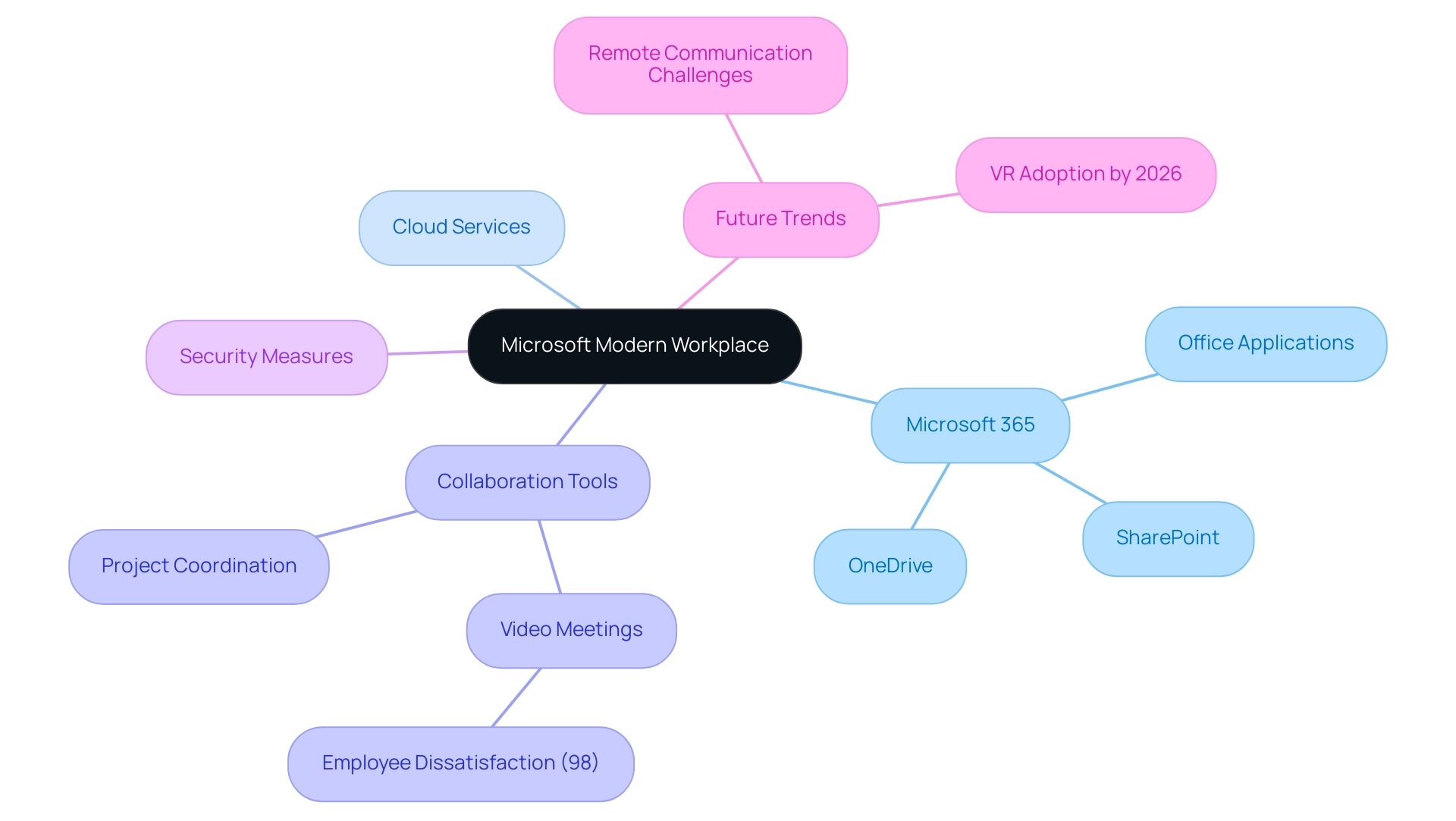
Key Benefits and Features of Microsoft Modern Workplace
Adopting a Microsoft modern work and security framework offers organizations a variety of benefits, particularly in the areas of collaboration, productivity improvement, and operational flexibility. Key features, such as real-time co-authoring within Office applications, empower teams to collaboratively create documents and presentations, irrespective of their physical locations. Integrated communication through Teams streamlines interactions, allowing for instant messaging, video conferencing, and file sharing, which are crucial for effective teamwork in today’s hybrid work environment.
Furthermore, robust project management tools within the suite facilitate planning and tracking progress with ease. With the company showcasing an impressive 11 exabytes of storage capacity built across its global data centers, entities can leverage this scalability through cloud storage solutions like OneDrive, ensuring secure access to files across devices and promoting agility and responsiveness in workflows. This immense storage capability illustrates the potential for organizations to generate more content through AI advancements, as highlighted in the case study titled 'Cloud Storage Capacity.'
Organizations can also harness advanced analytics resources to derive insights into employee performance and collaboration patterns, supported by AI-powered platforms on LinkedIn that provide personalized career insights, fostering a culture of continuous improvement and driving operational efficiency. As Conall O'Kane, Practice Manager of Modern Workplace, aptly states,
Whether you are in the office, on site or working from home, M365 ensures you stay connected and productive.
This ability to adjust to various working environments is a testament to the transformative power of tools that support Microsoft modern work and security.
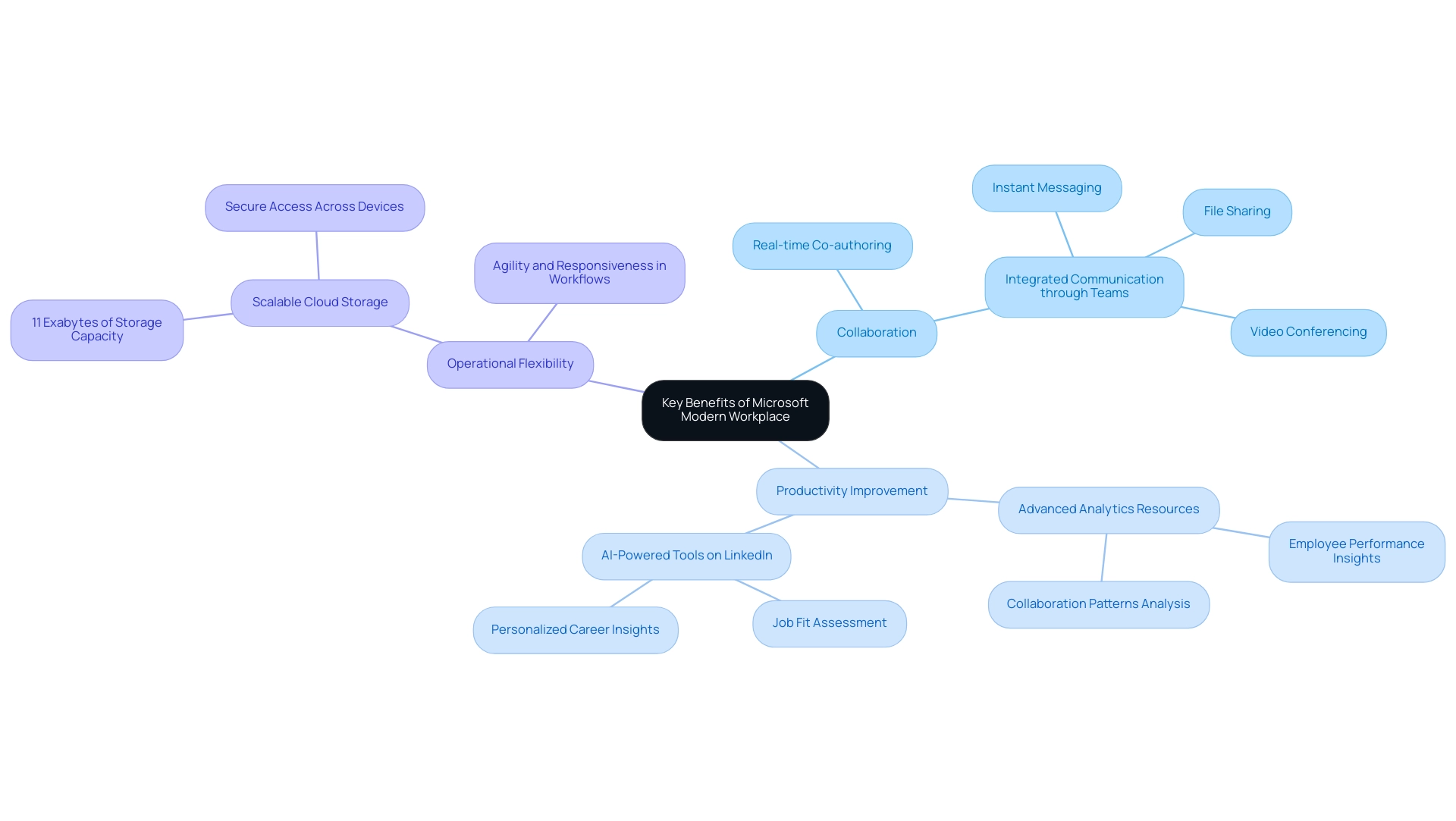
Ensuring Security and Compliance in the Modern Workplace
To effectively protect data within the Microsoft Modern Work and Security environment, entities must establish a comprehensive protective framework that encompasses:
- Multi-factor authentication (MFA)
- Data loss prevention (DLP) policies
- Routine safety assessments
The increasing complexity of cyber threats is underscored by the statistic that web application breaches account for 25% of all breaches, primarily due to stolen credentials. Notably, IT budgets will increase in 40 percent of entities in 2023, with a significant portion of this investment directed toward enhancing cybersecurity measures.
Utilizing Microsoft’s built-in protection features, such as Azure Active Directory and Microsoft Defender, is vital in the context of Microsoft modern work and security, as these tools are essential for entities aiming to enhance their defenses against evolving threats. Furthermore, entities must remain vigilant regarding compliance regulations, including GDPR and HIPAA, which present ongoing challenges in data handling. Regular audits and staff training on protocols are not merely recommended; they are essential for maintaining a robust stance and cultivating a culture of compliance.
Significantly, Reed Smith reports,
Cyber scams surged by 400 percent in March 2020, rendering COVID-19 the greatest-ever threat,
emphasizing the urgent need for entities to adjust their protective measures in reaction to changing challenges. Case studies reveal that the absence of real-time monitoring can severely hamper incident detection and response on remote devices. By utilizing remote monitoring resources, organizations can enhance their security oversight in accordance with Microsoft modern work and security, improving response times and ensuring a more secure environment in the ever-evolving landscape of remote work.
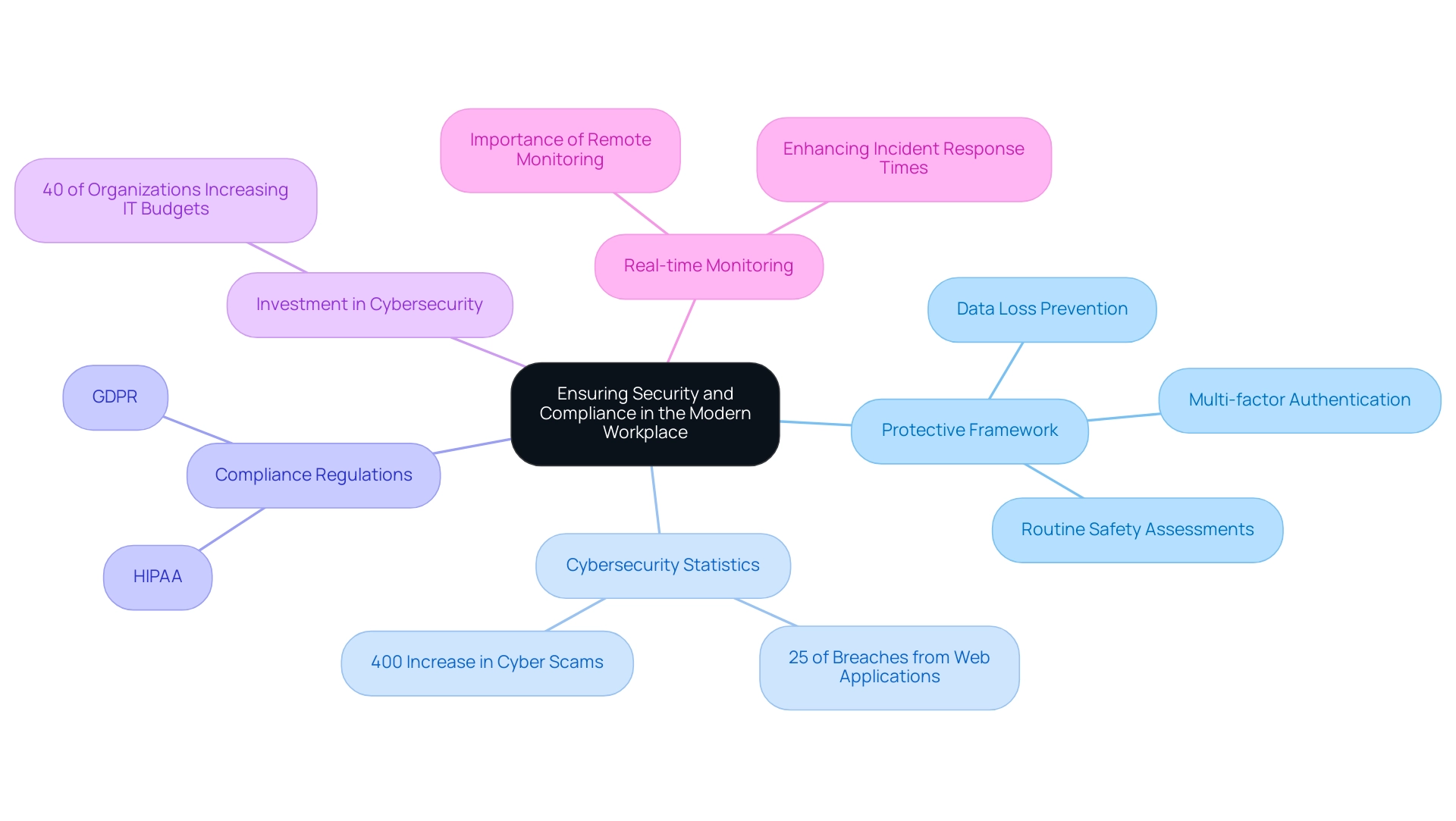
Strategies for Successful Change Management
Effective change management strategies are crucial for a successful transition to Microsoft modern work and security solutions. Organizations should initiate this process by articulating a clear vision and the benefits of the new workplace model to all employees. Research indicates that 94% of employees are likely to stay longer at a company that invests in their learning and development, highlighting the importance of a strong learning culture during transitions.
Engaging stakeholders from various departments early fosters a sense of ownership and commitment, which is essential for buy-in. Tailored training programs that cater to different user roles facilitate adaptation to new tools and processes, ensuring a smoother transition. Moreover, establishing a feedback mechanism empowers employees to voice concerns and suggestions, which can be addressed promptly, thereby easing the transition process.
Celebrating small wins regularly throughout the adoption journey not only builds momentum but also reinforces the value of these changes. As entities embrace change management in the context of Microsoft modern work and security, they cultivate a culture of adaptability and resilience, ultimately providing a competitive edge and preparing them for future transitions. Notably, global earnings in the collaboration applications sector increased by 28.4% in 2021, reaching $29.1 billion, underscoring the growing importance of effective change management in the digital landscape.
Additionally, change managers rate their job satisfaction at 4 out of 5 or higher, reflecting the positive impact that successful change initiatives can have on organizational culture. A case study on strengthened organizational agility illustrates how embracing change management cultivates a culture of adaptability and resilience, aiding in current technology implementation and preparing organizations to handle future changes more effectively.
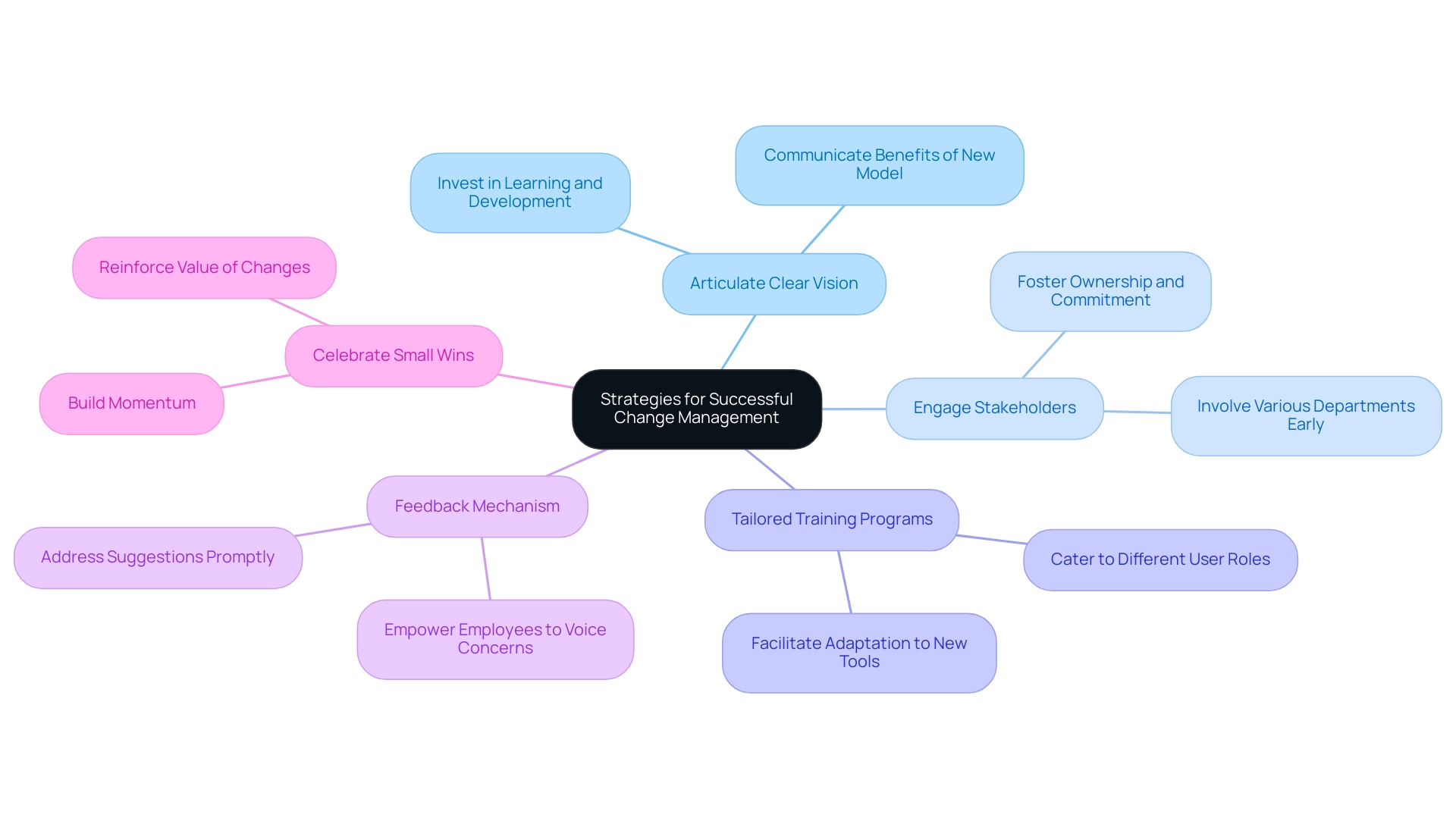
Enhancing Collaboration with Microsoft Teams
Teams is integral to enhancing collaboration within the Modern Workplace, particularly in today's hybrid work environment. The platform facilitates real-time communication through chat, video calls, and seamless integrations with various applications, enabling teams to collaborate effectively regardless of their physical location. Notably, during the COVID-19 pandemic, the usage of Teams skyrocketed, with video calls increasing by over 1000%, reflecting its vital role in maintaining productivity.
In April 2020 alone, Teams recorded an astounding 4.1 billion meeting minutes in a single day—a dramatic increase from just 0.56 billion at the beginning of March. This surge in usage highlights how essential the platform has become for remote work.
Features such as dedicated channels for specific projects or departments facilitate focused discussions and provide easier access to relevant information. Organizations can enhance productivity by implementing best practices, including:
- Establishing clear communication guidelines
- Using @mentions to prioritize urgent matters
According to data, between Q1 2020 and Q4 2023, the EMEA region accounted for the highest number of downloads of the Teams app, reaching approximately 27.4 million, underscoring its global adoption.
Furthermore, the average time between a user's first and last use of Teams in a day increased by over an hour during March 2020, emphasizing the platform's impact on user engagement and productivity.
By effectively leveraging Microsoft Teams, organizations can significantly improve team dynamics and overall performance, aligning their remote project management strategies with the demands of modern work environments.
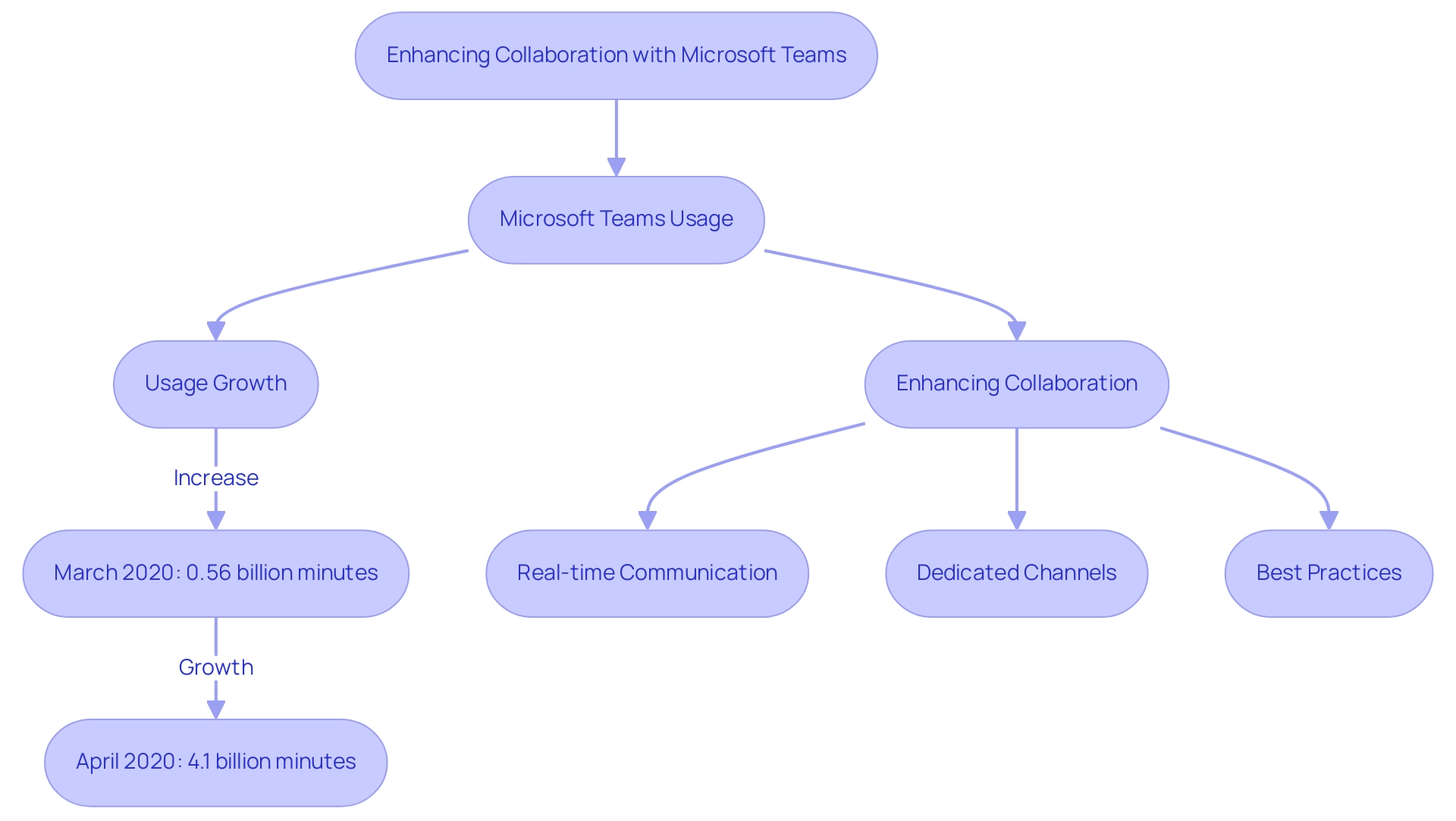
Conclusion
The Microsoft Modern Workplace is not merely an adaptation to current trends; it represents a fundamental shift in how organizations function and collaborate in an increasingly digital world. By integrating essential tools such as Microsoft 365, companies can foster a culture of productivity and flexibility that meets the demands of a hybrid workforce. The emphasis on real-time collaboration through platforms like Microsoft Teams, coupled with robust security measures, ensures that employees remain connected and secure, regardless of their physical location.
Moreover, the strategic implementation of change management practices is vital for organizations transitioning to this modern framework. Engaging employees, providing tailored training, and celebrating milestones are essential steps in cultivating a resilient workforce capable of navigating future challenges. As businesses prepare for the anticipated rise in technology adoption, including immersive solutions like Virtual Reality, the importance of a well-structured approach cannot be overstated.
In conclusion, embracing the Microsoft Modern Workplace equips organizations with the tools necessary to thrive in a rapidly evolving landscape. By prioritizing collaboration, security, and effective change management, companies can not only enhance operational efficiency but also empower their employees to excel in their roles. The future of work is here, and the Microsoft Modern Workplace is at the forefront, ready to redefine the way teams connect, collaborate, and succeed.




